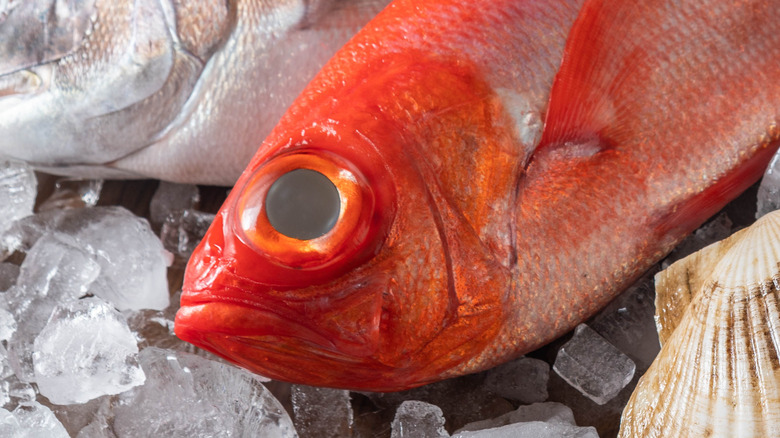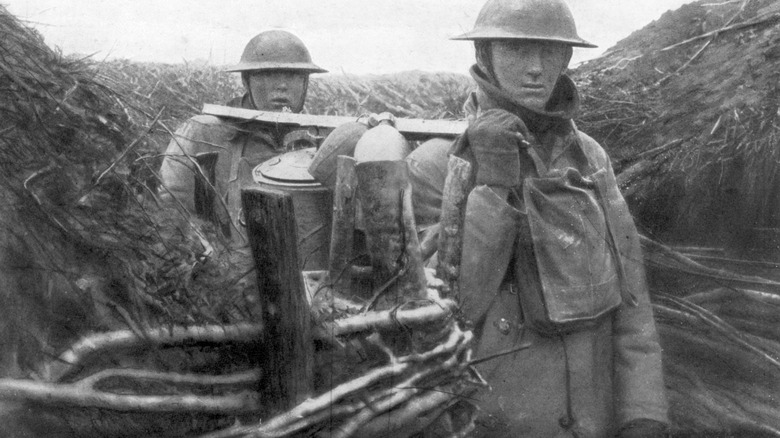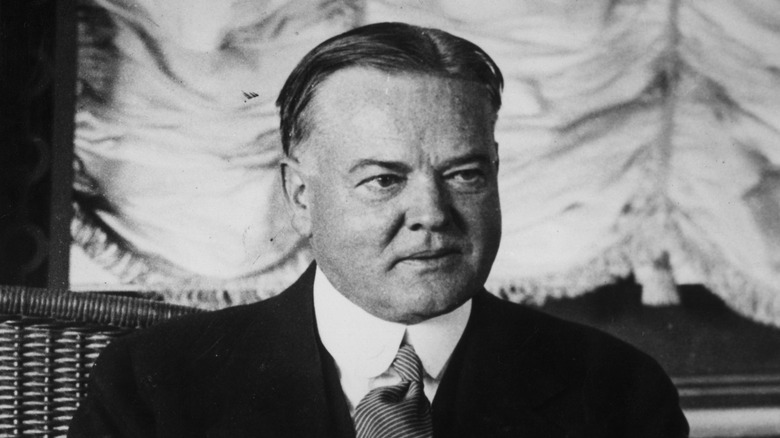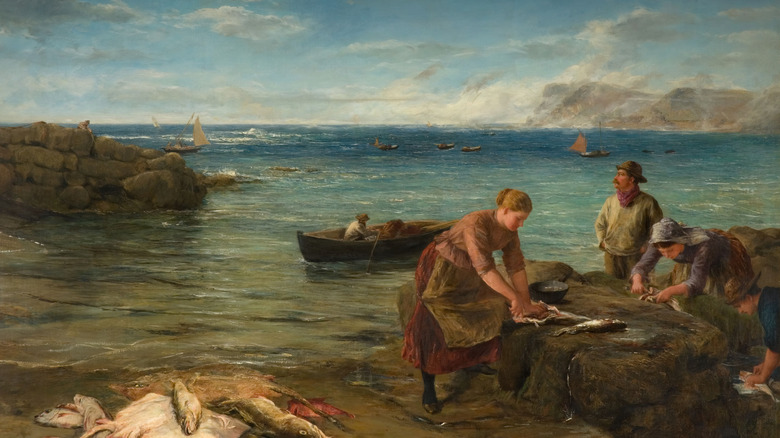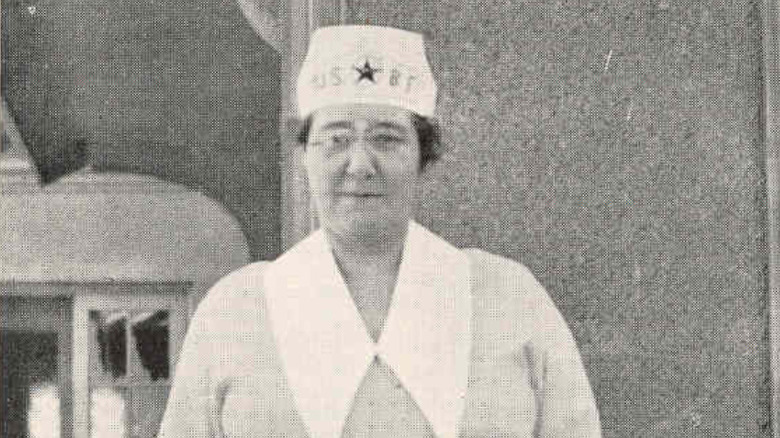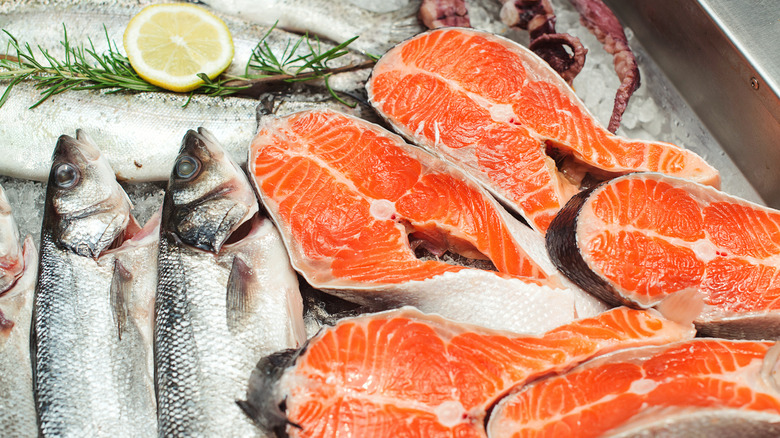How Evelene Spencer Weaponized Fish During WWI
The United States needed all hands on deck during World War I, and citizens were asked to help with the war effort in any way they could. One easy way for the average civilian to play a part in defeating the Central Powers — comprised of Germany, Austro-Hungary, Turkey, and their allies, per ThoughtCo — was by rationing food. The idea was that if the country cut back on food, what they didn't eat could be sent overseas to soldiers who could use it to stay properly nourished on the front lines. Of course, if food — namely meat — was being sent over to Europe, the folks at home needed to get their animal protein in some other way. So they turned to seafood.
According to Atlas Obscura, Evelene Spencer became the face of the government's campaign to encourage people to ration meat and other foods by eating seafood. She toured the country teaching people how to cook different kinds of seafood, and she was featured on posters plastered across the nation. Over time, Evelene Spencer became known as the "Fish Evangelist" thanks to how she pounded the pavement, spreading the good word about the virtues of eating fish.
The United States and World War I
According to ThoughtCo, World War I started when Astro-Hungary Archduke Franz Ferdinand was assassinated. The man who pulled the trigger was a Serbia activist named Gavrilo Princip who with several others was working with a terrorist organization called the Black Hand, which was connected to the Serbian Army. According to History, it's still unknown whether the Serbian government had any involvement in the assassination; regardless, Austro-Hungary declared war on Serbia. War was almost inevitable in the years leading up to World War I, and the archduke's assassination simply lit the powder keg. Serbia was backed by Russia, while Austro-Hungary received support from Germany. After that, most of Europe began picking sides and the continent descended into war.
Meanwhile, the United States did its best to stay out of it. A German U-Boat sank the British-owned ocean liner Lusitania in 1915, which had many Americans aboard. Great Britain thought the incident might draw the Americans into the war. Although the U.S. kept its nose clean, public opinion of Germany had soured (via History). Finally, in 1917, an intercepted telegram sent by German Foreign Minister Arthur Zimmerman proposed a German alliance with Mexico and announced intentions to sink any ship, including American-owned vessels. The United States officially entered World War I in April 1917.
Food rationing during World War I
According to History, the United States issued its first World War I food rationing edict in August 1917 and established the United States Food Administration. The USFA was led by Herbert Hoover (above), who went on to become president from 1929 to 1933. The USFA was in charge of everything that had to do with food and the war effort, including transporting it, distributing it, and conserving it.
There was concern, because the United States' allies were facing food difficulties in Europe, where once-prosperous farms had been converted into battlefields. Additionally, American soldiers needed to eat, so part of the nation's food supply had to be shipped overseas. Hoover's program was voluntary, and it used quick, simple slogans like "Food will win the war" to play off people's sense of patriotism and galvanize the public into helping the war effort.
Meanwhile, the United States Bureau of Fisheries launched its own companion campaign that helped the war effort and the seafood industry at the same time. They called it the Eat More Fish campaign, and its mission statement was right in its name (via Atlas Obscura).
Seafood was less than favorable at the time
There was a food pecking order in America during World War I, according to Atlas Obscura. Seafood was important for early colonists in the 1600 and 1700s, but by the 19th century, seafood had seen a massive fall from grace in the minds of the American public. Author Barton Seaver mentioned in his book "American Seafood: Heritage, Culture & Cookery from Sea to Shining Sea" that most people "considered fish being beneath our aspirations" (via Atlas Obscura).
The United States Department of Agriculture reported that just a few years before the United States was fully embroiled in World War I, the average American was eating 150 pounds of meat per year, compared to only 10 pounds of seafood.
Serving and eating meat was seen as a status symbol, so convincing people to give the practice up and eat seafood instead required a little bit of reprogramming. The USBF, followed Hoover's lead, put up posters that said things like "Fish is a fighting food" to get people all excited about eating fish. However, seafood still had that stigma attached from generations of eaters who saw it as beneath them. They needed a way to show people that seafood could be delicious if they prepared it the right way. That's where Evelene Spencer came in.
Evelene Spencer: Fish Evangelist
Eat More FIsh was Got Milk? before Got Milk? The USBF people needed a celebrity endorsement to help get their message across. According to Atlas Obscura, Evelene Spencer was born in Canada in 1868, and she was working as a restaurant manager in Portland Oregon when the USBF came calling for help with their "Eat More Fish" campaign.
Her job was to travel around the country and show Americans how to correctly prepare fish and seafood and encourage them to make it a larger part of their everyday diet. "As many of these fish are new to the average housewife, the demonstrations are intended to acquaint her with their merits, and at the same time broaden her knowledge of the possibilities of fish," the USBF said about Spencer's cooking demonstration tour. The demonstrations drew crowds, sometimes into the hundreds. Evelene Spencer was a bona fide celebrity chef before that was a thing, and her visage could be seen on posters and flyers across the country.
Spencer continued to promote fish cookery after the war
Spencer's efforts not only helped the war effort, but they helped people save money and increased the demand for fish, which in turn helped the seafood industry. "Instead of always purchasing the better-known, high-priced fish, choose the less-known and cheaper kinds," was a piece of pragmatic advice that she offered to home chefs at the time (via Atlas Obscura).
In 1921, Spencer teamed up with naturalist and author John Nathan Cobb to extol the virtues of fish cooking in written form. Their finished product was the 364-page, obscenely long-titled book "Fish Cookery: Six Hundred Recipes for the Preparation of Fish, Shellfish and Other Aquatic Animals, Including Fish Soups, Salads and Entrées, with Accompanying Sauces, Seasonings, Dressings and Forcemeats." Another one of Spencer's innovations was showing ways of calculating how long to cook a fish based on its size, which before Spencer, was something that came down to guesswork for the average cook.
After releasing her cookbook — which by all accounts extremely well — Spencer took a job with the National Fish Company in Canada in 1923. She died in 1935, having left an indelible mark on the culinary world.
